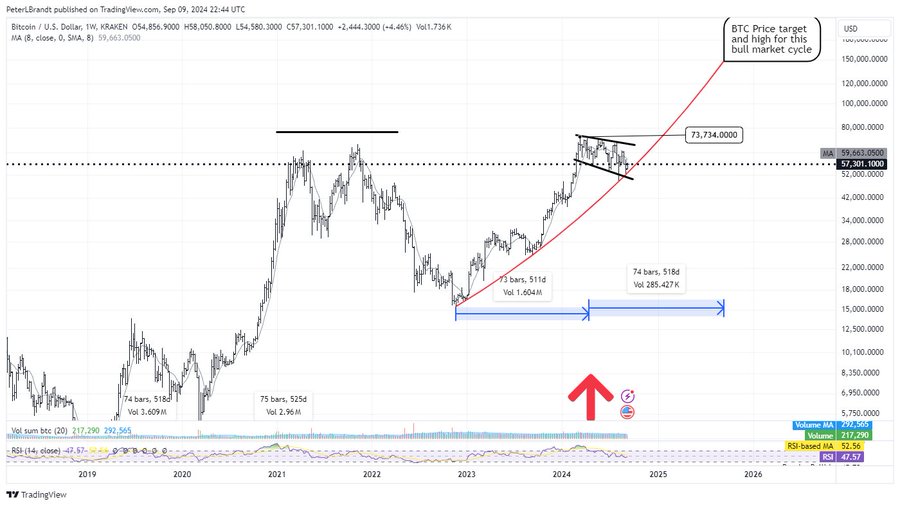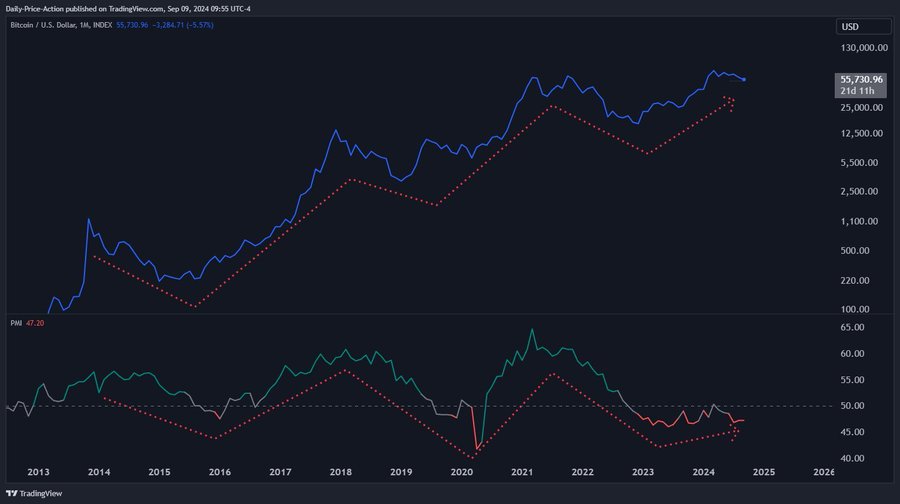Peter Brandt Predicts Bull Market High For Bitcoin, Here’s The Target

Highlights
- Peter Brandt has said that Bitcoin could rise to $150,000 by 2025
- Bernstein analysts and experts like Tom Lee have made a similar prediction for BTC
- US presidential elections and rate cuts could propel BTC to $150,000
Peter Brandt has predicted a bull market high for Bitcoin, suggesting that the flagship crypto will rise to $150,000 by 2025. This Bitcoin price prediction is similar to that of Bernstein analysts for BTC’s price earlier in the year. The leading crypto’s price has remained stagnant since reaching a new all-time high (ATH) of $73,000 in March. However, predictions like these show that it could still hit a new ATH in this market cycle.
Peter Brandt Predicts Bitcoin Will Hit $150,000 By 2025
Peter Brandt has predicted that Bitcoin will hit $150,000 by 2025. The accompanying chart he shared in an X post showed that this price would mark the high for BTC in this bull market cycle. Brandt had previously made a similar prediction and alluded to past halving cycles, with his analysis noting how BTC’s price had peaked between 16 to 18 months after every halving event.
It is worth mentioning that the veteran trader’s prediction aligns with those made by other analysts. In March, shortly after BTC’s price hit a new all-time high (ATH) of $73,000, Bernstein analysts said they were convinced that the leading crypto would reach $150,000 by 2025. They cited factors like the halving event, which eventually took place in April, and the success of the Spot Bitcoin ETFs as factors that would propel Bitcoin’s price growth in this bull run.
Fundstrat analyst Tom Lee predicted that Bitcoin would reach $150,000, although he stated that BTC would hit the price mark this year. Popular crypto analysts like Mikybull Crypto have also highlighted $150,000 as a price level Bitcoin can reach in this market cycle.
On the other hand, crypto analysts like Justin Bennett have offered a bearish outlook for BTC’s price and suggested that the crypto might not reach $150,000 as predicted by these Bitcoin bulls. He stated that contrary to what many think, the halving cycles don’t trigger bull runs and that BTC’s price is driven by economic cycles.
Bennett highlighted how Bitcoin has so far tracked the Purchasing Managers’ Index (PMI). The analyst claimed that BTC’s correlation with the PMI will not change during the next short-term or long-term contraction. Interestingly, the US PMI is currently at 47.20, representing a contraction. As such, BTC’s price could decline if the PMI index drops further.
Factors That Could Propel Bitcoin Price To $150,000
There are other factors that could propel BTC’s rise to $150,000, a price level that Peter Brandt predicts the crypto could reach in this bull market. One is the US presidential election coming up in November. Crypto has become one of the major talking points ahead of the election as both Donald Trump and Kamala Harris try to win over crypto voters.
For now, Donald Trump seems more popular among the crypto electorates as the former US President has clearly stated crypto policies he plans to implement if elected again as President. This is why analysts like Standard Chartered’s head of digital assets research, Geoff Kendrick, have highlighted a Trump victory as being very bullish for BTC. Kendrick had in June boldly predicted that Bitcoin would hit $150,000 by year-end if Trump emerges as the next US president. Bernstein analysts’ Bitcoin prediction is that the crypto would rise to $90,000 if Donald Trump wins.
Rate cuts by the US Federal Reserve are another factor that could propel Bitcoin to reach $150,000. BTC’s price remains stagnant primarily due to a lack of liquidity in its ecosystem. However, the Fed’s quantitative easing (QE) could solve this issue since investors and traders would be more confident about investing in a risk asset like Bitcoin.
The August US CPI inflation data showed that year-on-year inflation fell to 2.5%, its lowest in three years. This development indicates that the Fed will likely start cutting rates at its next FOMC meeting.
- Fed’s Hammack Signals No Rush to Cut Rates as January Hold Odds Near 80%
- XRP ETFs Reach $1.21B as Asset Managers See a ‘Third Path’ Beyond Bitcoin
- Nearly $50M in USDT Stolen After Address Poisoning Scam Targets Crypto Trader Wallet
- Breaking: Rep. Max Miller Unveils Crypto Tax Bill, Includes De Minimis Rules for Stablecoins
- XRP Holders Eye ‘Institutional Grade Yield’ as Ripple Engineer Details Upcoming XRPL Lending Protocol
- Will Solana Price Hit $150 as Mangocueticals Partners With Cube Group on $100M SOL Treasury?
- SUI Price Forecast After Bitwise Filed for SUI ETF With U.S. SEC – Is $3 Next?
- Bitcoin Price Alarming Pattern Points to a Dip to $80k as $2.7b Options Expires Today
- Dogecoin Price Prediction Points to $0.20 Rebound as Coinbase Launches Regulated DOGE Futures
- Pi Coin Price Prediction as Expert Warns Bitcoin May Hit $70k After BoJ Rate Hike
- Cardano Price Outlook: Will the NIGHT Token Demand Surge Trigger a Rebound?

 Claim $500
Claim $500
















